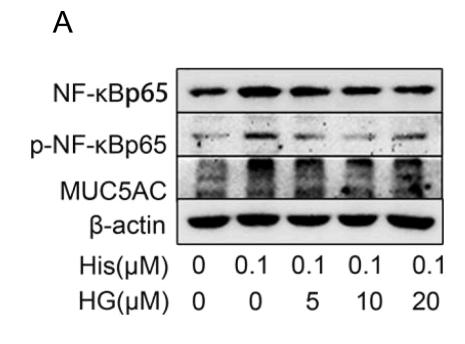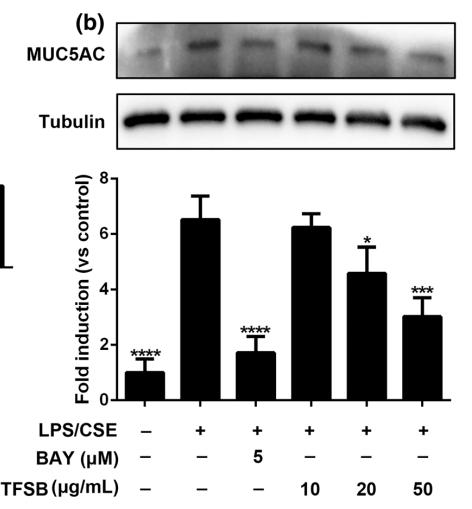MUC5A Antibody - #DF9639
| Product: | MUC5A Antibody |
| Catalog: | DF9639 |
| Description: | Rabbit polyclonal antibody to MUC5A |
| Application: | WB IF/ICC |
| Cited expt.: | WB |
| Reactivity: | Human, Rat |
| Prediction: | Pig |
| Mol.Wt.: | 586kDa; 586kD(Calculated). |
| Uniprot: | P98088 |
| RRID: | AB_2842835 |
Related Downloads
Protocols
Product Info
*The optimal dilutions should be determined by the end user.
*Tips:
WB: For western blot detection of denatured protein samples. IHC: For immunohistochemical detection of paraffin sections (IHC-p) or frozen sections (IHC-f) of tissue samples. IF/ICC: For immunofluorescence detection of cell samples. ELISA(peptide): For ELISA detection of antigenic peptide.
Cite Format: Affinity Biosciences Cat# DF9639, RRID:AB_2842835.
Fold/Unfold
Apomucin; Apomucin Major Airway Glycoprotein; Gastric mucin; LeB; Lewis B blood group antigen; Major Airway Glycoprotein; MUC 5; MUC5; MUC5AC; Mucin 5 subtype AC tracheobronchial; Mucin 5 Subtypes A And C; Mucin 5 subtypes A and C tracheobronchial/gastric; Mucin 5, tracheobronchial/gastric; Mucin 5AC; Mucin 5AC oligomeric mucus/gel forming; Mucin 5AC, oligomeric mucus/gel forming pseudogene; Mucin; TBM; Tracheobronchial Mucin (TBM); Tracheobronchial mucin;
Immunogens
A synthesized peptide derived from human MUC5A, corresponding to a region within C-terminal amino acids.
Highly expressed in surface mucosal cells of respiratory tract and stomach epithelia. Overexpressed in a number of carcinomas. Also expressed in Barrett's esophagus epithelium and in the proximal duodenum.
- P98088 MUC5A_HUMAN:
- Protein BLAST With
- NCBI/
- ExPASy/
- Uniprot
MSVGRRKLALLWALALALACTRHTGHAQDGSSESSYKHHPALSPIARGPSGVPLRGATVFPSLRTIPVVRASNPAHNGRVCSTWGSFHYKTFDGDVFRFPGLCNYVFSEHCGAAYEDFNIQLRRSQESAAPTLSRVLMKVDGVVIQLTKGSVLVNGHPVLLPFSQSGVLIQQSSSYTKVEARLGLVLMWNHDDSLLLELDTKYANKTCGLCGDFNGMPVVSELLSHNTKLTPMEFGNLQKMDDPTDQCQDPVPEPPRNCSTGFGICEELLHGQLFSGCVALVDVGSYLEACRQDLCFCEDTDLLSCVCHTLAEYSRQCTHAGGLPQDWRGPDFCPQKCPNNMQYHECRSPCADTCSNQEHSRACEDHCVAGCFCPEGTVLDDIGQTGCVPVSKCACVYNGAAYAPGATYSTDCTNCTCSGGRWSCQEVPCPGTCSVLGGAHFSTFDGKQYTVHGDCSYVLTKPCDSSAFTVLAELRRCGLTDSETCLKSVTLSLDGAQTVVVIKASGEVFLNQIYTQLPISAANVTIFRPSTFFIIAQTSLGLQLNLQLVPTMQLFMQLAPKLRGQTCGLCGNFNSIQADDFRTLSGVVEATAAAFFNTFKTQAACPNIRNSFEDPCSLSVENEKYAQHWCSQLTDADGPFGRCHAAVKPGTYYSNCMFDTCNCERSEDCLCAALSSYVHACAAKGVQLGGWRDGVCTKPMTTCPKSMTYHYHVSTCQPTCRSLSEGDITCSVGFIPVDGCICPKGTFLDDTGKCVQASNCPCYHRGSMIPNGESVHDSGAICTCTHGKLSCIGGQAPAPVCAAPMVFFDCRNATPGDTGAGCQKSCHTLDMTCYSPQCVPGCVCPDGLVADGEGGCITAEDCPCVHNEASYRAGQTIRVGCNTCTCDSRMWRCTDDPCLATCAVYGDGHYLTFDGQSYSFNGDCEYTLVQNHCGGKDSTQDSFRVVTENVPCGTTGTTCSKAIKIFLGGFELKLSHGKVEVIGTDESQEVPYTIRQMGIYLVVDTDIGLVLLWDKKTSIFINLSPEFKGRVCGLCGNFDDIAVNDFATRSRSVVGDVLEFGNSWKLSPSCPDALAPKDPCTANPFRKSWAQKQCSILHGPTFAACHAHVEPARYYEACVNDACACDSGGDCECFCTAVAAYAQACHEVGLCVSWRTPSICPLFCDYYNPEGQCEWHYQPCGVPCLRTCRNPRGDCLRDVRGLEGCYPKCPPEAPIFDEDKMQCVATCPTPPLPPRCHVHGKSYRPGAVVPSDKNCQSCLCTERGVECTYKAEACVCTYNGQRFHPGDVIYHTTDGTGGCISARCGANGTIERRVYPCSPTTPVPPTTFSFSTPPLVVSSTHTPSNGPSSAHTGPPSSAWPTTAGTSPRTRLPTASASLPPVCGEKCLWSPWMDVSRPGRGTDSGDFDTLENLRAHGYRVCESPRSVECRAEDAPGVPLRALGQRVQCSPDVGLTCRNREQASGLCYNYQIRVQCCTPLPCSTSSSPAQTTPPTTSKTTETRASGSSAPSSTPGTVSLSTARTTPAPGTATSVKKTFSTPSPPPVPATSTSSMSTTAPGTSVVSSKPTPTEPSTSSCLQELCTWTEWIDGSYPAPGINGGDFDTFQNLRDEGYTFCESPRSVQCRAESFPNTPLADLGQDVICSHTEGLICLNKNQLPPICYNYEIRIQCCETVNVCRDITRLPKTVATTRPTPHPTGAQTQTTFTTHMPSASTEQPTATSRGGPTATSVTQGTHTTLVTRNCHPRCTWTKWFDVDFPSPGPHGGDKETYNNIIRSGEKICRRPEEITRLQCRAKSHPEVSIEHLGQVVQCSREEGLVCRNQDQQGPFKMCLNYEVRVLCCETPRGCHMTSTPGSTSSSPAQTTPSTTSKTTETQASGSSAPSSTPGTVSLSTARTTPAPGTATSVKKTFSTPSPPPVPATSTSSMSTTAPGTSVVSSKPTPTEPSTSSCLQELCTWTEWIDGSYPAPGINGGDFDTFQNLRDEGYTFCESPRSVQCRAESFPNTPLADLGQDVICSHTEGLICLNKNQLPPICYNYEIRIQCCETVNVCRDITRPPKTVATTRPTPHPTGAQTQTTFTTHMPSASTEQPTATSRGGPTATSVTQGTHTTPVTRNCHPRCTWTTWFDVDFPSPGPHGGDKETYNNIIRSGEKICRRPEEITRLQCRAKSHPEVSIEHLGQVVQCSREEGLVCRNQDQQGPFKMCLNYEVRVLCCETPKGCPVTSTPVTAPSTPSGRATSPTQSTSSWQKSRTTTLVTTSTTSTPQTSTTYAHTTSTTSAPTARTTSAPTTRTTSASPASTTSGPGNTPSPVPTTSTISAPTTSITSAPTTSTTSAPTSSTTSGPGTTPSPVPTTSITSAPTTSTTSAPTTSTTSARTSSTTSATTTSRISGPETTPSPVPTTSTTSATTTSTTSAPTTSTTSAPTSSTTSSPQTSTTSAPTTSTTSGPGTTPSPVPTTSTTSAPTTRTTSAPKSSTTSAATTSTTSGPETTPRPVPTTSTTSSPTTSTTSAPTTSTTSASTTSTTSGAGTTPSPVPTTSTTSAPTTSTTSAPISSTTSATTTSTTSGPGTTPSPVPTTSTTSAPTTSTTSGPGTTPSAVPTTSITSAPTTSTNSAPISSTTSATTTSRISGPETTPSPVPTASTTSASTTSTTSGPGTTPSPVPTTSTISVPTTSTTSASTTSTTSASTTSTTSGPGTTPSPVPTTSTTSAPTTSTTSAPTTSTISAPTTSTTSATTTSTTSAPTPRRTSAPTTSTISASTTSTTSATTTSTTSATTTSTISAPTTSTTLSPTTSTTSTTITSTTSAPISSTTSTPQTSTTSAPTTSTTSGPGTTSSPVPTTSTTSAPTTSTTSAPTTRTTSVPTSSTTSTATTSTTSGPGTTPSPVPTTSTTSAPTTRTTSAPTTSTTSAPTTSTTSAPTSSTTSATTTSTISVPTTSTTSVPGTTPSPVPTTSTISVPTTSTTSASTTSTTSGPGTTPSPVPTTSTTSAPTTSTTSAPTTSTISAPTTSTPSAPTTSTTLAPTTSTTSAPTTSTTSTPTSSTTSSPQTSTTSASTTSITSGPGTTPSPVPTTSTTSAPTTSTTSAATTSTISAPTTSTTSAPTTSTTSASTASKTSGLGTTPSPIPTTSTTSPPTTSTTSASTASKTSGPGTTPSPVPTTSTIFAPRTSTTSASTTSTTPGPGTTPSPVPTTSTASVSKTSTSHVSISKTTHSQPVTRDCHLRCTWTKWFDIDFPSPGPHGGDKETYNNIIRSGEKICRRPEEITRLQCRAESHPEVSIEHLGQVVQCSREEGLVCRNQDQQGPFKMCLNYEVRVLCCETPKGCPVTSTPVTAPSTPSGRATSPTQSTSSWQKSRTTTLVTTSTTSTPQTSTTSAPTTSTTSAPTTSTTSAPTTSTTSTPQTSISSAPTSSTTSAPTSSTISARTTSIISAPTTSTTSSPTTSTTSATTTSTTSAPTSSTTSTPQTSKTSAATSSTTSGSGTTPSPVTTTSTASVSKTSTSHVSVSKTTHSQPVTRDCHPRCTWTKWFDVDFPSPGPHGGDKETYNNIIRSGEKICRRPEEITRLQCRAKSHPEVSIEHLGQVVQCSREEGLVCRNQDQQGPFKMCLNYEVRVLCCETPKGCPVTSTSVTAPSTPSGRATSPTQSTSSWQKSRTTTLVTSSITSTTQTSTTSAPTTSTTPASIPSTTSAPTTSTTSAPTTSTTSAPTTSTTSTPQTTTSSAPTSSTTSAPTTSTISAPTTSTISAPTTSTTSAPTASTTSAPTSTSSAPTTNTTSAPTTSTTSAPITSTISAPTTSTTSTPQTSTISSPTTSTTSTPQTSTTSSPTTSTTSAPTTSTTSAPTTSTTSTPQTSISSAPTSSTTSAPTASTISAPTTSTTSFHTTSTTSPPTSSTSSTPQTSKTSAATSSTTSGSGTTPSPVPTTSTASVSKTSTSHVSVSKTTHSQPVTRDCHPRCTWTKWFDVDFPSPGPHGGDKETYNNIIRSGEKICRRPEEITRLQCRAESHPEVSIEHLGQVVQCSREEGLVCRNQDQQGPFKMCLNYEVRVLCCETPKGCPVTSTPVTAPSTPSGRATSPTQSTSSWQKSRTTTLVTTSTTSTPQTSTTSAPTTSTIPASTPSTTSAPTTSTTSAPTTSTTSAPTHRTTSGPTTSTTLAPTTSTTSAPTTSTNSAPTTSTISASTTSTISAPTTSTISSPTSSTTSTPQTSKTSAATSSTTSGSGTTPSPVPTTSTTSASTTSTTSAPTTSTTSGPGTTPSPVPSTSTTSAATTSTTSAPTTRTTSAPTSSMTSGPGTTPSPVPTTSTTSAPTTSTTSGPGTTPSPVPTTSTTSAPITSTTSGPGSTPSPVPTTSTTSAPTTSTTSASTASTTSGPGTTPSPVPTTSTTSAPTTRTTSASTASTTSGPGSTPSPVPTTSTTSAPTTRTTPASTASTTSGPGTTPSPVPTTSTTSASTTSTISLPTTSTTSAPITSMTSGPGTTPSPVPTTSTTSAPTTSTTSASTASTTSGPGTTPSPVPTTSTTSAPTTSTTSASTASTTSGPGTSLSPVPTTSTTSAPTTSTTSGPGTTPSPVPTTSTTSAPTTSTTSGPGTTPSPVPTTSTTPVSKTSTSHLSVSKTTHSQPVTSDCHPLCAWTKWFDVDFPSPGPHGGDKETYNNIIRSGEKICRRPEEITRLQCRAESHPEVNIEHLGQVVQCSREEGLVCRNQDQQGPFKMCLNYEVRVLCCETPRGCPVTSVTPYGTSPTNALYPSLSTSMVSASVASTSVASSSVASSSVAYSTQTCFCNVADRLYPAGSTIYRHRDLAGHCYYALCSQDCQVVRGVDSDCPSTTLPPAPATSPSISTSEPVTELGCPNAVPPRKKGETWATPNCSEATCEGNNVISLRPRTCPRVEKPTCANGYPAVKVADQDGCCHHYQCQCVCSGWGDPHYITFDGTYYTFLDNCTYVLVQQIVPVYGHFRVLVDNYFCGAEDGLSCPRSIILEYHQDRVVLTRKPVHGVMTNEIIFNNKVVSPGFRKNGIVVSRIGVKMYATIPELGVQVMFSGLIFSVEVPFSKFANNTEGQCGTCTNDRKDECRTPRGTVVASCSEMSGLWNVSIPDQPACHRPHPTPTTVGPTTVGSTTVGPTTVGSTTVGPTTPPAPCLPSPICQLILSKVFEPCHTVIPPLLFYEGCVFDRCHMTDLDVVCSSLELYAALCASHDICIDWRGRTGHMCPFTCPADKVYQPCGPSNPSYCYGNDSASLGALPEAGPITEGCFCPEGMTLFSTSAQVCVPTGCPRCLGPHGEPVKVGHTVGMDCQECTCEAATWTLTCRPKLCPLPPACPLPGFVPVPAAPQAGQCCPQYSCACNTSRCPAPVGCPEGARAIPTYQEGACCPVQNCSWTVCSINGTLYQPGAVVSSSLCETCRCELPGGPPSDAFVVSCETQICNTHCPVGFEYQEQSGQCCGTCVQVACVTNTSKSPAHLFYPGETWSDAGNHCVTHQCEKHQDGLVVVTTKKACPPLSCSLDEARMSKDGCCRFCPPPPPPYQNQSTCAVYHRSLIIQQQGCSSSEPVRLAYCRGNCGDSSSMYSLEGNTVEHRCQCCQELRTSLRNVTLHCTDGSSRAFSYTEVEECGCMGRRCPAPGDTQHSEEAEPEPSQEAESGSWERGVPVSPMH
Predictions
Score>80(red) has high confidence and is suggested to be used for WB detection. *The prediction model is mainly based on the alignment of immunogen sequences, the results are for reference only, not as the basis of quality assurance.
High(score>80) Medium(80>score>50) Low(score<50) No confidence
Research Backgrounds
Gel-forming glycoprotein of gastric and respiratory tract epithelia that protects the mucosa from infection and chemical damage by binding to inhaled microorganisms and particles that are subsequently removed by the mucociliary system. Interacts with H.pylori in the gastric epithelium, Barrett's esophagus as well as in gastric metaplasia of the duodenum (GMD).
C-, O- and N-glycosylated. O-glycosylated on the second and last Thr of the Thr-/Ser-rich tandem repeats TTPSPVPTTSTTSA. One form of glycosylation is also known as Lewis B (LeB) blood group antigen, a tetrasaccharide consisting of N-acetylglucosamine having a fucosyl residue attached. It has a role as an epitope and antigen and functions as a receptor for H.pylori binding and facilitates infection. C-mannosylation in the Cys-rich subdomains may be required for proper folding of these regions and for export from the endoplasmic reticulum during biosynthesis.
Proteolytic cleavage in the C-terminal is initiated early in the secretory pathway and does not involve a serine protease. The extent of cleavage is increased in the acidic parts of the secretory pathway. Cleavage generates a reactive group which could link the protein to a primary amide.
Secreted.
Highly expressed in surface mucosal cells of respiratory tract and stomach epithelia. Overexpressed in a number of carcinomas. Also expressed in Barrett's esophagus epithelium and in the proximal duodenum.
The cysteine residues in the Cys-rich subdomain repeats are not involved in disulfide bonding.
Research Fields
· Organismal Systems > Immune system > IL-17 signaling pathway. (View pathway)
References
Application: WB Species: Human Sample: human nasal epithelial cell
Application: WB Species: human Sample: HBE16 cells
Application: IHC Species: mouse Sample: lung
Restrictive clause
Affinity Biosciences tests all products strictly. Citations are provided as a resource for additional applications that have not been validated by Affinity Biosciences. Please choose the appropriate format for each application and consult Materials and Methods sections for additional details about the use of any product in these publications.
For Research Use Only.
Not for use in diagnostic or therapeutic procedures. Not for resale. Not for distribution without written consent. Affinity Biosciences will not be held responsible for patent infringement or other violations that may occur with the use of our products. Affinity Biosciences, Affinity Biosciences Logo and all other trademarks are the property of Affinity Biosciences LTD.




